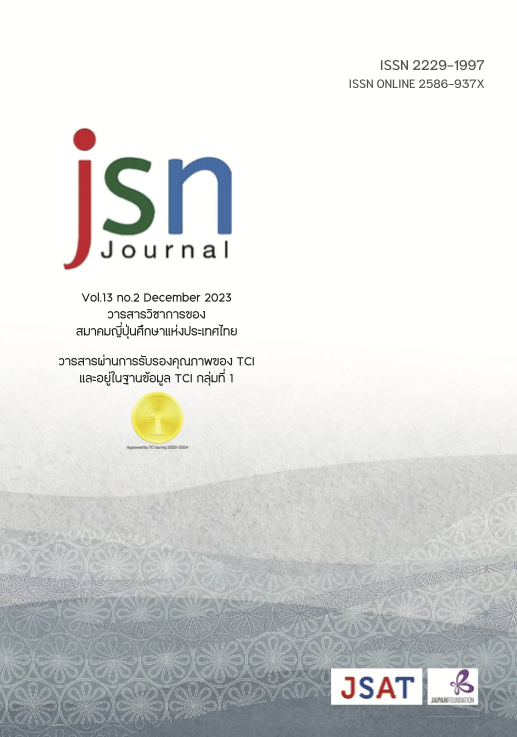A Study of the Request-Responses Found in the Quick Response Listening on Japanese-Language Proficiency Test
Main Article Content
Abstract
The purpose of this study is to investigate request utterances and their responses in the quick response listening part of Japanese-Language Proficiency Test (JLPT) N2. For the analysis, 53 utterances in N2 and 46 of those in N3 which met the pragmatic conditions were extracted from 43 JLPT workbooks in order to examine the differences between the two levels. The results of the data observation revealed that in the N2 workbooks, a request in the form of asking permission by using “-temorattemoiika” was found. In addition, negative expressions, sentence-final expressions such as “wakeniwaikanai” and introductory remarks such as “osashitsukaenakereba” were used as well. As for the response, the numbers of negative acceptances and responses where listeners inquired about the request rather than provided prompt replies were remarkable. It can be said that these request-response patterns are often observed in daily life, and therefore they correspond with the linguistic competence required for N2, which states that one is able to comprehend orally presented materials such as coherent conversations. Based on the results of this study, it is expected that Japanese instructors might be able to design teaching methods for N2 preparation so that learners would develop skills for tests and as a result, communicate more efficiently in the future.
Article Details

This work is licensed under a Creative Commons Attribution-NonCommercial-NoDerivatives 4.0 International License.
ข้อความและข้อคิดเห็นต่างๆ ในบทความเป็นของผู้เขียนบทความนั้นๆ ไม่ใช่ความเห็นของกองบรรณาธิการหรือของวารสาร jsn Journal
References
คาโอริ นากามุระ, ซาชิ ฟุกุชิมะ และเอทสึโกะ โทโมมัทสึ. (2555). เตรียมสอบวัดระดับ N2 การฟัง [新完全マスター聴解日本語能力試験N2] (สมจิตร์ สิริรัตนวิทย์, ผู้แปล). กรุงเทพฯ: สำนักพิมพ์ภาษาและวัฒนธรรม สสท. (ต้นฉบับพิมพ์ ปี ค.ศ.2011)
ASK Publishing. (2564). แนวข้อสอบ JLPT N2 [はじめての日本語能力試験 合格模試N2] (เมธี ธรรมพิภพ, ผู้แปล). กรุงเทพฯ: สำนักพิมพ์ภาษาและวัฒนธรรม สสท. (ต้นฉบับพิมพ์ ปี ค.ศ.2020)
Group Jammassy. (2554). พจนานุกรมรูปประโยคภาษาญี่ปุ่น [日本語文型辞典] (บุษบา บรรจงมณี, ปราณี จงสุจริตธรรม , ประภา แสงทองสุข และวันชัย สีลพัทธ์กุล, ผู้แปล). กรุงเทพฯ: สำนักพิมพ์ภาษาและวัฒนธรรม สสท. (ต้นฉบับพิมพ์ ปี ค.ศ.1998)
Damrongchai, N. (2013). Japanese Speaking Personnel Proficiency Deficiencies: A Case Study of Japanese Education in Thailand. Journal of Language Teaching and Research, 4 (2), 348-356.
板橋貴子(2010).「日本語能力試験聴解「即時応答」における解答プロセス」『 国際交流基金日本語教育紀要』16, 17-28.
国際交流基金・日本国際教育支援協会(2010). 『新しい「日本語能力試験」ガイドブック』https://www.jlpt.jp/reference/pdf/guidebook1.pdf สืบค้นวันที่ 5 สิงหาคม 2566
国際交流基金・日本国際教育支援協会(2012). 『日本語能力試験 公式問題集N3』東京: 凡人社.
国際交流基金・日本国際教育支援協会(2018). 『日本語能力試験 公式問題集 第二集N2』東京: 凡人社.
日本語記述文法研究会編(2003). 『現代日本語文法4 第8部 モダリティ』東京: くろしお出版.
益岡隆志・田窪行則(1992). 『基礎日本語文法-改訂版-』東京: くろしお出版.
山岡政紀・牧原功・小野正樹(2010). 『コミュニケーションと配慮表現―日本語語用論入門』東京: 明治書院.
李奇楠(2004).「依頼に対する応答の諸相」『研究誌 ことば』25, 38-49.


